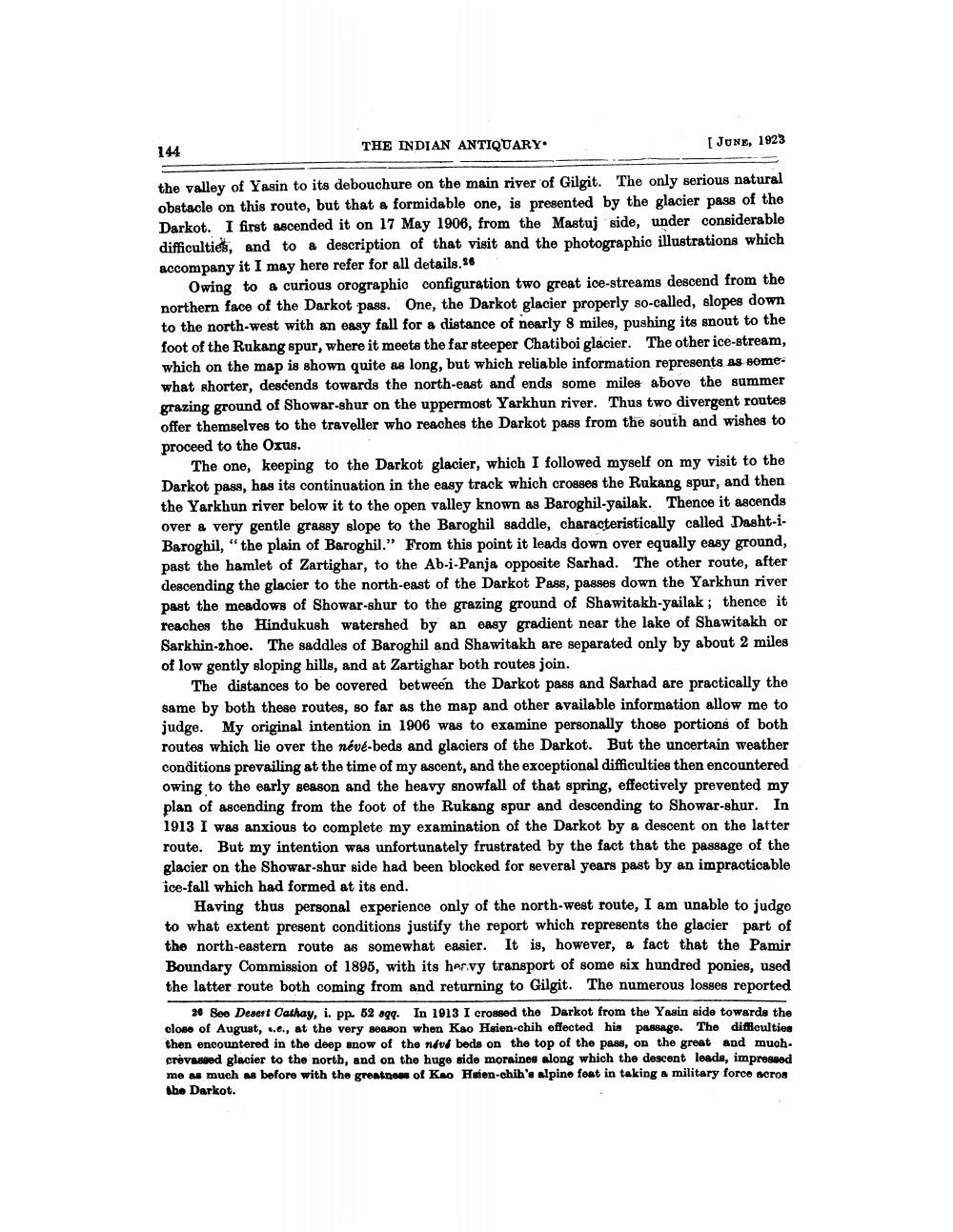________________
144
THE INDIAN ANTIQUARY
[ JUNE, 1923
the valley of Yasin to its debouchure on the main river of Gilgit. The only serious natural obstacle on this route, but that a formidable one, is presented by the glacier pass of the Darkot. I first ascended it on 17 May 1906, from the Mastuj side, under considerable difficulties, and to a description of that visit and the photographic illustrations which accompany it I may here refer for all details. 26
Owing to a curious orographio configuration two great ice-streams descend from the northern face of the Darkot pass. One, the Darkot glacier properly so-called, slopes down to the north-west with an easy fall for a distance of nearly 8 miles, pushing its snout to the foot of the Rukang spur, where it meets the far steeper Chatiboi glacier. The other ice-stream, which on the map is shown quite as long, but which reliable information represents as somewhat shorter, descends towards the north-east and ends some miles above the summer grazing ground of Showar-shur on the uppermost Yarkhun river. Thus two divergent routes offer themselves to the traveller who reaches the Darkot pass from the south and wishes to proceed to the Oxug.
The one, keeping to the Darkot glacier, which I followed myself on my visit to the Darkot pass, has its continuation in the easy track which crosses the Rukang spur, and then the Yarkhun river below it to the open valley known as Baroghil-yailak. Thenoe it ascends over a very gentle grassy slope to the Baroghil saddle, characteristically called Dasht-iBaroghil, “the plain of Baroghil." From this point it leads down over equally easy ground, past the hamlet of Zartighar, to the Ab-i-Panja opposite Sarhad. The other route, after descending the glacier to the north-east of the Darkot Pass, passes down the Yarkhun river past the meadows of Showar-shur to the grazing ground of Shawitakh-yailak; thence it reaches the Hindukush watershed by an easy gradient near the lake of Shawitakh or Sarkhin-zhoe. The saddles of Baroghil and Shawitakh are separated only by about 2 miles of low gently sloping hills, and at Zartighar both routes join.
The distances to be covered between the Darkot pass and Sarhad are practically the same by both these routes, so far as the map and other available information allow me to judge. My original intention in 1906 was to examine personally those portions of both routes which lie over the néve-beds and glaciers of the Darkot. But the uncertain weather conditions prevailing at the time of my ascent, and the exceptional difficulties then encountered owing to the early season and the heavy snowfall of that spring, effectively prevented my plan of ascending from the foot of the Rukang spur and descending to Showar-shur. In 1913 I was anxious to complete my examination of the Darkot by a descent on the latter route. But my intention was unfortunately frustrated by the fact that the passage of the glacier on the Showar-shur side had been blocked for several years past by an impracticable ice-fall which had formed at its end.
Having thus personal experience only of the north-west route, I am unable to judge to what extent present conditions justify the report which represents the glacier part of the north-eastern route as somewhat easier. It is, however, a fact that the Pamir Boundary Commission of 1895, with its hervy transport of some six hundred ponies, used the latter route both coming from and returning to Gilgit. The numerous losses reported
20 Soo Desert Cathay, i. pp. 52 age. In 1913 I crossed the Darkot from the Yasin side towards the close of August, s.e., at the very season when Kao Hsien-chih effected his passage. The difficulties then encountered in the deep snow of the new beds on the top of the pass, on the great and much. créased glacier to the north, and on the huge side morainee along which the descent leads, impressed me as much as before with the greatness of Keo Hsien-chih's alpino feat in taking a military force acros the Darkot.




